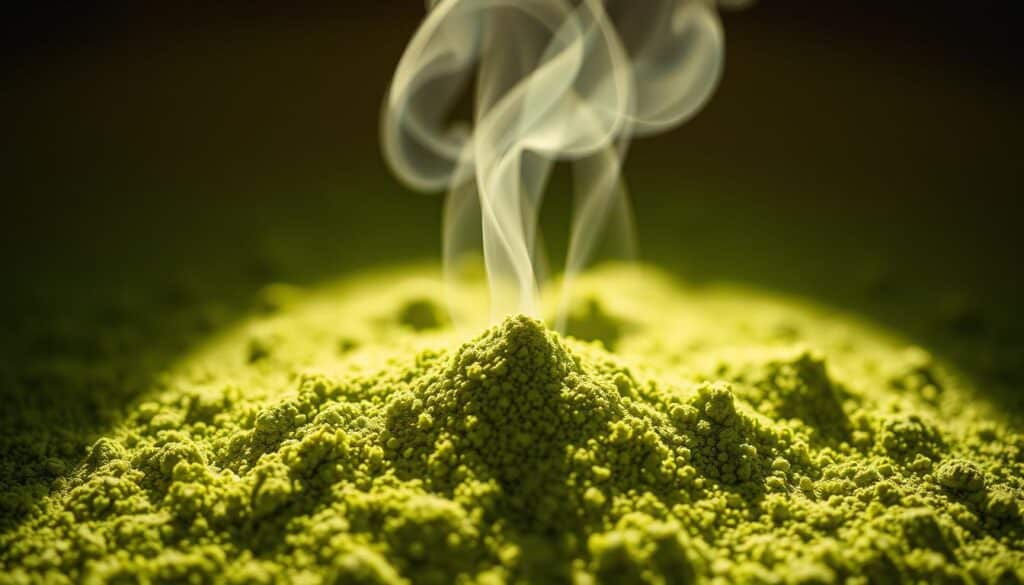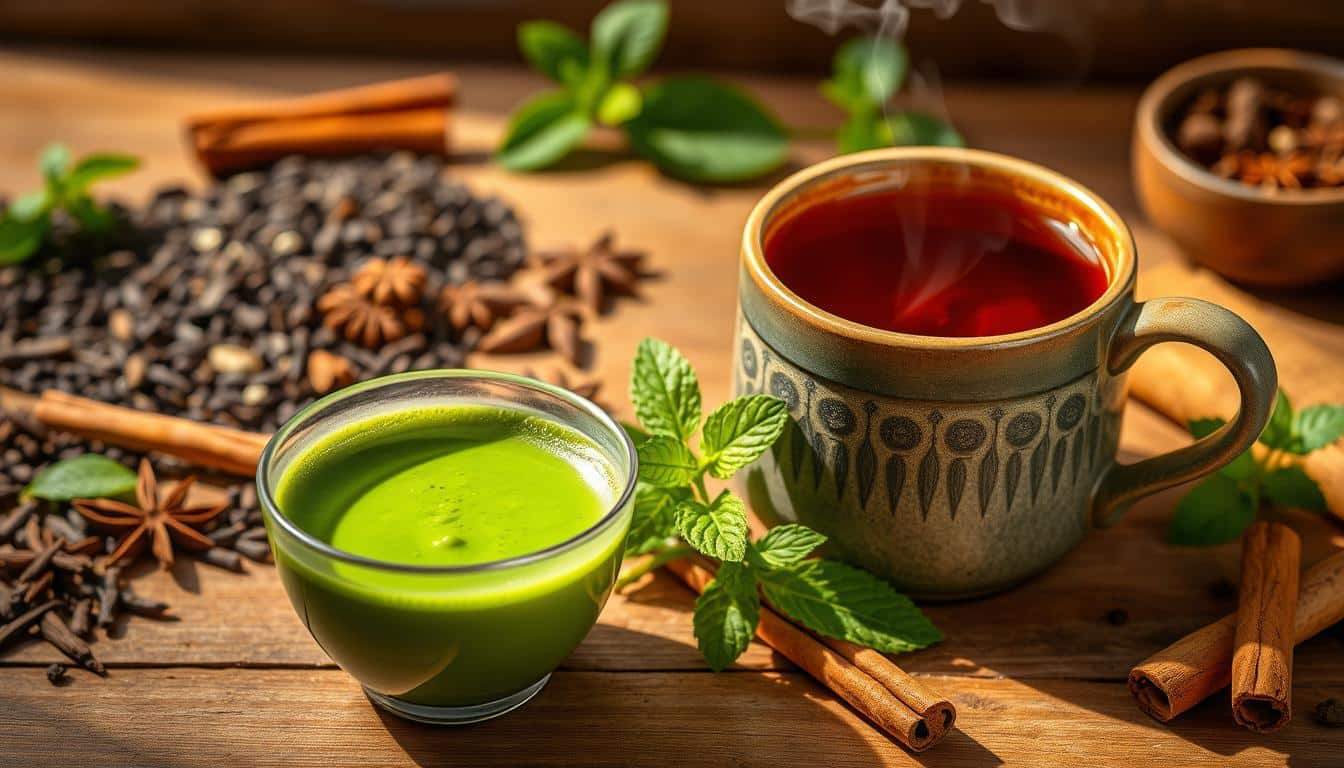The first time I had matcha, I was amazed by its bright green color. It filled me with calm energy. This reminded me of a Japanese tea house where the tea master whisked the matcha with care.
This experience was so peaceful and enriching. It made me love matcha’s unique flavors and health benefits.
Later, I tried chai at an Indian cultural festival. The smell of ginger, cardamom, and cinnamon was amazing. It felt like the bustling markets of India, where chai is a big part of life.
This leads to a big question: matcha vs chai. Both teas are deeply rooted in culture and offer many health benefits. They give different tastes and feelings. Whether you like matcha’s calm taste or chai’s spicy warmth, both have many fans.
Key Takeaways
- Matcha and chai come from deep cultural roots in Japan and India.
- Both teas have special tastes and smells for different tastes.
- Matcha is known for its bright green color and calm energy.
- Chai is loved for its warm spices and cozy taste.
- Learning about matcha and chai’s health benefits helps pick the right tea for you.
- Knowing how to make both teas can make you enjoy them more.
Introduction to Matcha and Chai
Tea lovers often talk about matcha and chai. These teas come from different places and have rich histories. Matcha is a green tea from Japan known for its creamy taste and deep flavor. It’s loved for its calming effects, thanks to Zen monks who used it for centuries.
Chai, on the other hand, is from India. It’s made with black tea and spices like cardamom and ginger. This mix gives chai a warm and spicy taste that feels like a hug in a cup.
When we talk about matcha vs chai taste, we see two special teas. Matcha has earthy flavors, while chai is bold and spicy. Their different tastes show the unique cultures behind each tea.
Looking into the history of matcha and chai, we find more than just drinks. It’s a trip through time and tradition. As we explore these teas, we’ll discover a world of flavors, health perks, and recipes that have crossed borders. For a full guide, check out our detailed comparison at Matcha vs Chai: Exploring Two Unique Tea.
Origins and Cultural Significance
Traditional teas like Japanese green tea and Indian chai have deep roots. They connect us to cultures and traditions. These drinks are more than just something to drink; they open doors to understanding and connection.
Matcha: A Japanese Tradition

Matcha has been loved by Japanese Zen monks for ages. It started in China but found its spiritual home in Japan. Here, it became key to the Japanese tea ceremony.
The leaves for Japanese green tea are grown in the shade. They are then ground into a fine powder, making a vibrant green drink. The best matcha is ceremonial-grade, made from the youngest leaves.
This tradition teaches us about the art of tea-making. It also teaches us about mindfulness and peace.
Chai: An Indian Heritage
Chai is a big part of Indian culture. Its history is full of mystery, with tales of an old king making the first masala chai. By the mid-1830s, the British started tea plantations in India.
Locals mixed black tea with spices, milk, and sugar to make masala chai. This spicy and sweet drink is now a symbol of Indian hospitality. It’s often enjoyed in homes, showing warmth and community.
Learn more about these stories on the Everyday Dose blog. We dive into the cultural importance and interesting histories of these timeless drinks.
Matcha vs Chai: Flavor Profiles and Aromas
Exploring matcha and chai reveals a world of different tastes. Each sip is a journey that awakens your senses and lifts your spirit.
Matcha Flavor and Aroma
The scent of matcha aroma is fresh and green, like Japan’s tea fields. It smells of grass and a bit sweet. When you drink it, matcha tastes vegetal and a bit bitter, but also creamy.
This mix of tastes makes matcha both energizing and calming. Drinking it becomes a special moment.
Chai Flavor and Aroma
Chai, on the other hand, is a mix of spices that grabs your attention. The tea flavor profiles are rich and complex, with a spicy warmth. Spices like cinnamon and cardamom blend together beautifully.
The black tea base, with milk and sugar, makes chai comforting and lively. When choosing between chai vs matcha taste, it’s all about what you like more. Do you prefer matcha’s grassy taste or chai’s spicy warmth?

| Attribute | Matcha | Chai |
|---|---|---|
| Primary Flavor | Grassy, Slightly Bitter | Spicy, Warm |
| Aroma | Green, Fresh | Spiced, Invigorating |
| Body | Creamy | Rich, Full-bodied |
Health Benefits of Matcha
Exploring matcha is more than just a fun tea experience. It brings many health benefits that can change your life. Matcha is full of antioxidants and helps detoxify, making it key to good health.
Antioxidant Powerhouse
Matcha is famous for its antioxidants. It has a lot of EGCG, which is good for your heart and might lower cancer risk. Matcha antioxidants protect your body from harm, keeping you healthy.
Detoxification Properties
Matcha is also known for detoxifying. It has a lot of chlorophyll, making it a top detoxifying tea. Chlorophyll cleanses your body, removing toxins. This makes matcha great for a natural cleanse.
| Health Aspect | Matcha Benefit |
|---|---|
| Antioxidants | High levels of EGCG and other antioxidants |
| Detoxification | Rich in chlorophyll for effective detox |
| Heart Health | Supports cardiovascular health |
| Cancer Prevention | Potentially reduces cancer risk |
Health Benefits of Chai
Chai tea is great for your health. It’s full of spices that taste good and are good for you. Chai can help your body feel better in many ways.
Anti-inflammatory and Immune Boosting
Chai tea has anti-inflammatory spices like cinnamon, cardamom, and ginger. These spices can help reduce inflammation. This can make symptoms of chronic conditions better.
Ginger in chai can help with pain and boost your immune system. This is especially good during flu season. The spices in chai work together to keep your immune system strong.
Digestive Health
Chai tea is also good for your digestion. Spices like ginger and cardamom help your body digest food better. This can help with bloating and indigestion.
Drinking chai every day can make your gut health better. It’s a great way to keep your digestive system healthy.
| Health Benefit | Primary Spice | Impact |
|---|---|---|
| Anti-inflammatory | Cinnamon | Reduces inflammation |
| Immune Boosting | Ginger | Boosts immune function |
| Digestive Aid | Cardamom | Stimulates digestive enzymes |
Want to find the perfect mix of health and taste? Check out this guide on Matcha vs Chai. See the benefits for yourself and enjoy a cup of wellness every day. 🌿☕
Matcha vs Chai: Preparation and Recipes
Preparing matcha and chai is a special and calming experience. Each tea has its own way of being made and special traditions. Let’s explore how to make the perfect cup of both, adding joy to your daily routine.
Traditional Matcha Preparation
Making matcha is a historical and mindful art. You’ll need high-quality matcha powder, a bamboo whisk, a scoop, and a ceramic bowl.
- Scoop 1-2 teaspoons of matcha powder into the bowl with the scoop.
- Add a bit of hot water (not boiling) to the bowl.
- Whisk the matcha in a zigzag motion until it’s frothy and smooth.
- Enjoy your matcha as is, or make a latte by adding steamed milk and honey.
Classic Chai Recipe
Chai tea latte lovers, rejoice! Making chai is about rich spices and hearty ingredients. Here’s how to make a classic chai:
- Ingredients: Black tea, fresh ginger, cardamom, clove, cinnamon, black pepper, milk, and sweetener of choice.
- Instructions:
- In a pot, mix water with ginger, cardamom, cloves, cinnamon, and black pepper. Bring to a boil.
- Add black tea leaves and simmer for 5-10 minutes.
- Pour in milk and your sweetener, heating until warm.
- Strain into a mug and enjoy your homemade chai tea latte.
| Aspect | Matcha | Chai |
|---|---|---|
| Ingredients | Matcha powder, water | Black tea, spices, milk |
| Tools | Whisk, bowl, scoop | Pot, strainer |
| Preparation Style | Whisking | Simmering |
Whether you prefer a matcha latte or a chai tea latte, making it is a journey. Each sip is not just about taste but a full experience that feeds your body and soul.
Conclusion
We’ve ended our journey of matcha vs chai, and both teas are truly special. Matcha fans love its smooth, grassy taste. Chai lovers enjoy its rich, spicy flavors. Each tea offers unique benefits.
Matcha fans find peace in its green color and health benefits. It’s full of antioxidants and helps detoxify. If you’re looking for the best matcha, try different brands to find your favorite.
Chai fans get comfort from its anti-inflammatory effects and good digestion. It’s a warm hug in every sip.
It’s not about who wins in matcha vs chai. It’s about enjoying the special moments each tea brings. Whether you prefer matcha’s calm rituals or chai’s aromatic journey, every sip is a chance to relax and enjoy. For more info, check out this resource.


